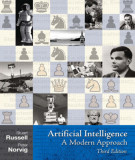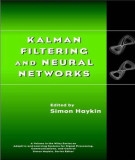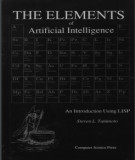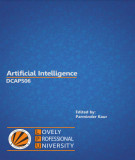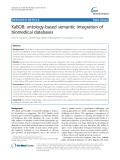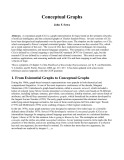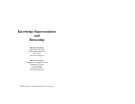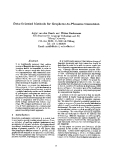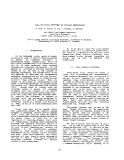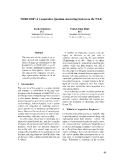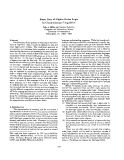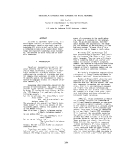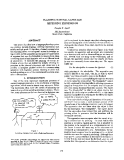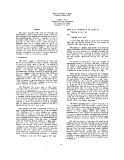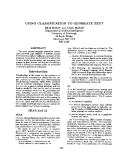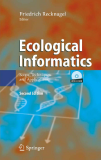
Knowledge representation and reasoning
-
Part 1 book "Artificial intelligence - A modern approach" includes content: Introduction, intelligent agents, solving problems by searching, beyond classical search, adversarial search, constraint satisfaction problems, logical agents, first order logic, inference in first order logic, classical planning, planning and acting in the real world, knowledge representation, quantifying uncertainty, probabilistic reasoning.
 584p
584p  muasambanhan05
muasambanhan05
 16-01-2024
16-01-2024
 6
6
 1
1
 Download
Download
-
Ebook "Judea pearl - Probabilistic reasoning in intelligent systems" includes content: Uncertainty in ai systems - an overview, bayesian inference, markov and bayesian networks - two graphical representations of probabilistic knowledge, belief updating by network propagation,...and other contents.
 557p
557p  haojiubujain07
haojiubujain07
 20-09-2023
20-09-2023
 7
7
 3
3
 Download
Download
-
Ebook "The elements of artificial intelligence using lisp" includes content: Introduction, programming in LISP, production systems and pattern matching, knowledge representation, search, logical reasoning, probabilistic reasoning, learning, natural language understanding, expert systems, vision, the future.
 553p
553p  haojiubujain07
haojiubujain07
 20-09-2023
20-09-2023
 8
8
 3
3
 Download
Download
-
Ebook Artificial intelligence: Part 2 presents the following content: Symbolic reasoning under uncertainty; statistical reasoning; weak slot and filler structures; strong slot and filler structures; natural language processing;...Please refer to the documentation for more details.
 119p
119p  chankora
chankora
 16-06-2023
16-06-2023
 7
7
 3
3
 Download
Download
-
This paper, combining natural language processing with knowledge representation and reasoning, aimed to implement such a question answering chatbot in pure Vietnamese to help students with their programming related questions.
 13p
13p  viellenkullman
viellenkullman
 16-05-2022
16-05-2022
 37
37
 1
1
 Download
Download
-
The proposed approach allows the representation, handling and utilisation of different levels of uncertainty in knowledge. This allows transformation-based fuzzy rule interpolation techniques to model and harness additional uncertain information in order to implement an effective fuzzy interpolative reasoning system.
 17p
17p  guernsey
guernsey
 28-12-2021
28-12-2021
 14
14
 0
0
 Download
Download
-
The ability to query many independent biological databases using a common ontology-based semantic model would facilitate deeper integration and more effective utilization of these diverse and rapidly growing resources. Despite ongoing work moving toward shared data formats and linked identifiers, significant problems persist in semantic data integration in order to establish shared identity and shared meaning across heterogeneous biomedical data sources.
 21p
21p  vikentucky2711
vikentucky2711
 24-11-2020
24-11-2020
 18
18
 1
1
 Download
Download
-
A conceptual graph is a graph representation for logic based on the semantic networks of artificial intelligence and the existential graphs of Charles Sanders Peirce. Several versions of CGs have been designed and implemented over the past thirty years. The simplest are the typeless core CGs, which correspond to Peirce’s original existential graphs. More common are the extended CGs, which are a typed superset of the core. The research CGs have explored novel techniques for reasoning, knowledge representation, and natural language semantics.
 26p
26p  superboss1194
superboss1194
 21-10-2015
21-10-2015
 45
45
 3
3
 Download
Download
-
The philosophy of Tài liệu Knowledge Representation and Reasonin is different from each of these. Here, we concentrate on reasoning as much as on representation.
 179p
179p  miragevn
miragevn
 06-10-2014
06-10-2014
 65
65
 5
5
 Download
Download
-
It is traditionally assumed that various sources of linguistic knowledge and their interaction should be formalised in order to be able to convert words into their phonemic representations with reasonable accuracy. We show that using supervised learning techniques, based on a corpus of transcribed words, the same and even better performance can be achieved, without explicit modeling of linguistic knowledge. In this paper we present two instances of this approach.
 9p
9p  buncha_1
buncha_1
 08-05-2013
08-05-2013
 47
47
 3
3
 Download
Download
-
We are interested in the nature of content structures in terms of which it would be possible to account for reasoning processes in understanding natural language texts. One of the most crucial problems here at the present time is: how and by which mechanisms these reasoning processes are controlled and directed.
 3p
3p  buncha_1
buncha_1
 08-05-2013
08-05-2013
 39
39
 3
3
 Download
Download
-
The main aim of this project is to explore, develop and evaluate the contribution of language technologies to the development of WEBCOOP, a system that provides intelligent Cooperative responses to Web queries. Such a system requires the integration of knowledge representation and the use of advanced reasoning procedures.
 4p
4p  bunthai_1
bunthai_1
 06-05-2013
06-05-2013
 36
36
 2
2
 Download
Download
-
Consideration of the question of meaning in the framework of linguistics often requires an allusion to sets and other higher-order notions. The traditional approach to representing and reasoning about meaning in a computational setting has been to use knowledge representation sys 7 tems that are either based on first-order logic or that use mechanisms whose formal justifications are to be provided after the fact. In this paper we shall consider the use of a higher-order logic for this task. We first present a version of definite clauses (positive Horn clauses) that is based on this logic.
 10p
10p  bungio_1
bungio_1
 03-05-2013
03-05-2013
 30
30
 1
1
 Download
Download
-
In order to represent speech acts, in a multi-agent context, we choose a knowledge representation based on the modal logic of knowledge KT4 which is defined by Sato. Such a formalism allows us to reason about knowledge and represent knowledge about knowledge, the notions of truth value and of definite reference.
 6p
6p  bungio_1
bungio_1
 03-05-2013
03-05-2013
 38
38
 1
1
 Download
Download
-
This paper describes how a language-planning system can produce natural-language referring expressions that satisfy multiple goals. It describes a formal representation for reasoning about several agents' mutual knowledge using possible-worlds semantics and the general organization of a system that uses the formalism to reason about plans combining physical and linguistic actions at different levels of abstraction.
 5p
5p  bungio_1
bungio_1
 03-05-2013
03-05-2013
 43
43
 1
1
 Download
Download
-
This paper considers what types of knowledge one must possess in order to reason about actions. Rather than concentrating on how actions are performed, as is done in the problem-solving literature, it examines the set of conditions under which an action can be said to have occurred. In other words, if one is told that action A occurred, what can be inferred about the state of the world? In particular, if the representation can define such conditions, it must have good models of time, belief, and intention. ...
 6p
6p  bungio_1
bungio_1
 03-05-2013
03-05-2013
 40
40
 2
2
 Download
Download
-
The IDAS natural-language generation system uses a KL-ONE type classifier to perform content determination, surface realisation, and part of text planning. Generation-by-classification allows IDAS to use a single representation and reasoning component for both domain and linguistic knowledge, which is difficult for systems based on unification or systemic generation techniques.
 8p
8p  bunmoc_1
bunmoc_1
 20-04-2013
20-04-2013
 46
46
 3
3
 Download
Download
-
The Fuzzy Set Theory developed by L. Zadeh (Zadeh 1965) as a possible way to handle uncertainty is particularly useful for the representation of vague expert knowledge and processing uncertain or imprecise information. The Fuzzy Set Theory is based on an extension of the classical meaning of the term "set" and formulates specific logical and arithmetical operations for processing information defined in the form of fuzzy sets and fuzzy rules.
 0p
0p  phoebe75
phoebe75
 01-02-2013
01-02-2013
 55
55
 6
6
 Download
Download
CHỦ ĐỀ BẠN MUỐN TÌM








